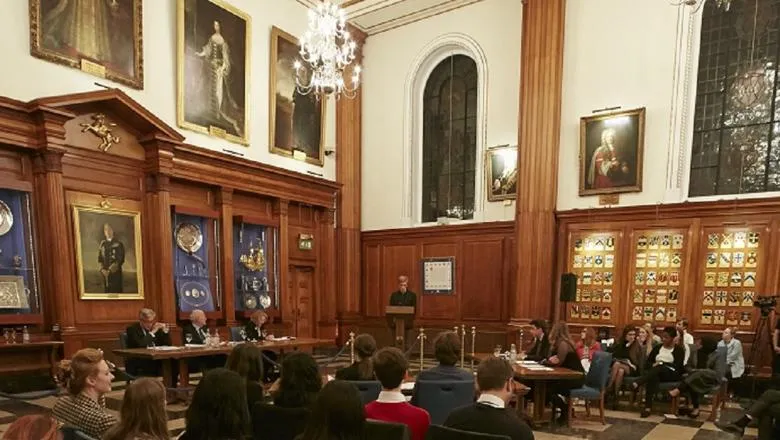01 September 2014
Law Courts of the World
The Moot Competition is an important tradition in legal education. Law Courts of the World is displayed in the School’s Moot Courtroom.

September 2014 – ongoing.
In a Moot, students put into practice what they have learned in the classroom. Marshalling legal opinions before a judge, arguing for and against an appeal, students develop their skills in analysis, reasoning, advocacy and public speaking.
The display in the Moot Court and Anteroom in Somerset House East Wing aims to create a sense of place and purpose for legal discussion surrounded by images of Law Courts of the World.
Law courts hold a special place in both the history of civic architecture and in the administration of justice. Not all law is practiced in a courtroom, but the court represents the place of the law, the space within which justice is done and seen to be done. The court is a place of juridical spectacle, privileged speech and the authority of law. Courts are places of gravity; a theatre of dramatic gestures and where permanent legal documents are created. The buildings themselves are often places of grandeur and beauty, embodying stability, tradition and gravitas. The law courts, from the four corners of the globe displayed in these rooms, represent one of the most significant forms of building design. Prominent architects are often commissioned to design law buildings which are frequently laden with symbolism and reflect prevailing trends in architectural philosophy and design. Until the mid-20th century, European architects used classical columns, gothic arches, high plinths, ceremonial steps and the dome to establish a vocabulary for domestic and colonial public buildings. The post-war era witnessed the transition to stylistic prescriptions advocated by modernist architects such as Corbusier and Niemeyer; these pervaded worldwide public building design and can be seen here in the courthouses of India and Brazil.
These photographs illustrate the interiors and exteriors of some of the finest palaces of justice around globe where many of our alumni spend their working lives. This display of the Law Courts World reflects the place of The Dickson Poon School of Law as a leading global law school rooted within the tradition of an English legal education.
Law Courts of the World is permanently displayed on level one (Moot Court and Ante Room) in Somerset House East Wing.
Credits
- Martin Abrams (Install)
- David Bank (Photographer)
- Rebecca Banks (Operations Assistant, The Dickson Poon School of Law)
- Nicola Barrett (Compliance Coordinator, Estates & Facilities)
- Timothy Bennett (General Manager, Metro Imaging)
- Ronald Blyde (Building Fabric Technician, Estates & Facilities)
- Professor Ben Bowling (Academic Lead, The Dickson Poon School of Law)
- Brian Burt (CPL Graphics)
- John Cleur (Digital Operator, Metro Imaging)
- Dolly Clew (Photographer)
- Sophie Cornell (Projects Coordinator, King's Cultural Institute)
- Rebecca Degener (Executive Suite Coordinator, Learning Centre Manager, King's Venues)
- Nirun Dowlath (Photographer)
- Scott Frances (Photographer)
- Charles Henty (Secondary of London and Under Sheriff, High Bailiff of Southwark, Central Criminal Court, Old Bailey)
- Herman van Hulzen (Photographer)
- Jessica Kaczorowski (Scott Frances Photography and HOUSE Studio, LLC)
- Luc Mercelis (Photographer)
- Sunny L. Merindo (Photographer)
- Rebecca Muscat (PA to the Secondary, Central Criminal Court, Old Bailey)
- Gemma Noyce (Events Officer, The Dickson Poon School of Law)
- Paul Prudence (Photographer)
- Jason A. N. Smith (Photographer)
- Leonie Taylor (Senior Communications Officer, The Dickson Poon School of Law)
- Ms Julie Thomas (Principal's Executive Officer {Projects & Institutional Liaison})
- Adam Tupper (Overall Project Manager)
- Sean Watts (Photographer)
- Tony Window (General Manager, Metro Imaging)
- Lynn Yeo (Designer
